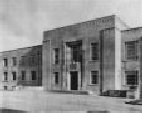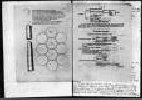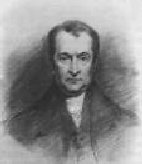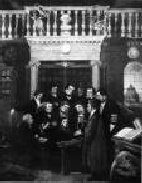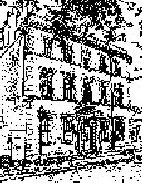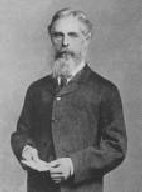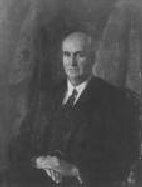
A.S. Russell
R. K. Callow, after graduating
in chemistry in 1923, was awarded a research scholarship at
Christ Church. His research interests moved to biochemistry,
first at the Rothamstead Experimental Station and then as member of
the scientific staff of the Medical Research Council. One of his
slightly unusual interests was in the Bee Research Association, where
he was a notable member for many years. J. R. (later Sir John) Maddox
joined Christ Church as an Exhibitioner in 1943, was awarded first
class honours in chemistry in 1947 and was subsequently a lecturer
at Manchester University. In due course he became the distinguished
editor of Nature between 1966 and 1973, and from 1980 – years which saw
monumental progress in science, especially in molecular biology. In 2000,
he was elected an Honorary Fellow of the Royal Society.
|
|
I
n Michaelmas 1919, the War over, a vast intake of undergraduates
took place, a feature which was to be repeated in the following
year and after. The principal task facing the College was the total
re-creation of its life and academic structure. In 1920, A. S. Russell,
MC, a Glasgow graduate who had worked with Nernst, Rutherford and Soddy,
was appointed to the Lee's Readership in Chemistry. Russell had already
made fundamental discoveries in the field of radioactivity, and it
is arguable that the term and concept of an "isotope" was originated
by him. At the same time, T. B. Heaton, an old Houseman, was elected
Lee's Reader in Anatomy. Both gave themselves unstintingly to the restructuring
process and to the enormous teaching load it entailed. For most of the
1920s, Oxford colleges had undergraduate populations covering a wide
age range and often with vast experience of the War and its aftermath.
I
n the 1920s, Russell continued his research in radioactivity in the
College laboratory, still retaining a curiosity for possible numerical
relationships between isotopes. He expanded his interests into amalgams,
and inter-metallic species, on which he published a number of papers.
The College laboratory provided experimental teaching courses in
inorganic chemistry for undergraduates from all Oxford colleges.
The arrangement for sharing specialist areas of experimental chemistry
amongst the various college laboratories had been devised by Baker at
the beginning of the century. Elsewhere, organic chemistry was located
at Queen's College, analytical chemistry at Magdalen, and physical chemistry
at the Trinity-Balliol laboratory and at Jesus College.
Russell
did not take large numbers of pupils on his tutorial list, but
those he did were well chosen and many went on to make notable contributions
to science and the world at large. One of his freshmen pupils was
W. H. Auden, who came up in 1925. Russell used to say that he knew
Auden would not last in chemistry as his essays were capable of beginning
"Of all the elements, beryllium is the most beautiful". Auden changed
to PPE after his first year and then to English in his final year, in
which he was awarded an honourable Third. But Auden used to say later
that he wished he had stayed with science because he would have liked
to have been a doctor, like his father. Russell's other pupils included
Dr C. H. Collie (later Lee’s Reader in Physics), Professor A. R.
J. P. Ubbelohde FRS, Dr R. K. Callow FRS and Sir John Maddox FRS, to
name but a few.
I
n the years leading up to the Second World War, Russell played an
increasing part in the College's administration, and in 1938 became
Censor, a position which he held with dedication and devotion throughout
the War. This time matters were different. Previously, universities
being denuded of their students in the 1914 – 18 War, the country
found itself by about 1916 with a diminishing number of scientists,
doctors and mathematicians. In the 1939 – 45 War, male undergraduates
studying chemistry, physics, mathematics, engineering and medicine
were allowed to continue, albeit under concentrated and more intensive
conditions. All had to undergo, simultaneously, preliminary military
training with the Senior Training Corps, and in many cases they were
required also to undertake fire-watching duties or some other form of
Civil Defence on a regular rota. Women students continued much as in peacetime.
Many senior members of the University with specialised scientific expertise
were called away to Government Research Establishments, and those in
the humanities were not wholly exempt from the national requirements,
as in the encypherment establishments and intelligence service. The teaching
structure of Christ Church and of Oxford, however, remained substantially
intact, awaiting the inevitable flood of undergraduates which followed
the War's end.
|
|
Ubbelohde came to the UK as a refugee from
Belgium at the time of the First World War and matriculated as a
scholar of Christ Church in 1926. In the course of an outstanding
undergraduate career, he won the Dukes Prize for French, the University's
Gibbs Prize for Chemistry and gained a first class honours degree.
He studied at Gottingen in Eucken's laboratory, there developing
his interests in thermodynamics. Subsequently he was Professor of
Chemistry at Queens University, Belfast, and then of Thermodynamics
at Imperial College, London, and was elected FRS in 1951. Ubbelohde
was unquestionably an outstanding intellect with multiple talents,
breadth of mind and a cultivated personality. He was elected an Honorary
Student of Christ Church in 1979.
|




